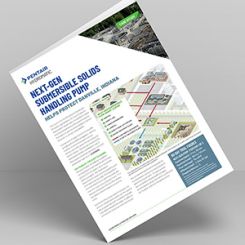The Western European nation has 20 mobile diesel-driven pumps on standby, ready to assist in national and international emergencies.
BBA Pumps
11/07/2016
One of the smallest and most densely populated countries in Western Europe, the Netherlands has nearly 10 million residents who live and work below sea level. Without active water management and primary flood defenses, the Netherlands’ lowest point would be up to 7 meters (23 feet) under water.
 Image 1. A fleet of mobile diesel-driven emergency pumps remain on standby, ready to assist in national and international emergencies. (Images courtesy of BBA Pumps)
Image 1. A fleet of mobile diesel-driven emergency pumps remain on standby, ready to assist in national and international emergencies. (Images courtesy of BBA Pumps)History
In 1953 a catastrophic flood hit the Netherlands, claiming more than 1,800 lives and leaving large areas of the country’s southwest region submerged for some time. After repairs to the dikes, water from the flooded areas needed to be removed with mobile emergency pumps, but a limited number of pumps were available in the country. Image 2. The ultra-high-flow pump sets with a total flow up to 25,000 cubic meters an hour, or about 110,000 gallons per minute, in use after heavy rainfall in the Netherlands.
Image 2. The ultra-high-flow pump sets with a total flow up to 25,000 cubic meters an hour, or about 110,000 gallons per minute, in use after heavy rainfall in the Netherlands.New Fleet of Pumps
In the early 2000s, the DCC decided to replace its pump fleet after decades of loyal service. This was not solely because of the pumps’ age, but instead because of additional complications including the lack of available spare parts, unacceptable noise levels and oil leakages. In 2004, a budget was approved for purchasing 20 new mobile pump sets, including the necessary piping work. Initially, 10 high-flow pump sets with a capacity of 3,000 m3/hour (13,200 gpm) were delivered. Four years later, 10 ultra-high-flow pump sets with a capacity of 5,000 m3/hour (22,000 gpm) arrived. A Dutch company was awarded the contract in 2008 for the manufacture of these 10 ultra-high flow pump sets. The company had more than 60 years of experience in the production of pipes and pump systems and specialized in the manufacture of mobile diesel-driven pumps.The Design
As one of the DCC pump experts responsible for the 2008 pump investment and through his experience in the field, Dick Verbaan, technical adviser asset management, defined the need for the new design of the pump units. “The standard pump equipment available on the market was no longer suitable for our requirements. The focus on weight was critical since the pumps had to be transported quickly, often over muddy roads and embankments,” Verbaan said. “Further, for international deployments, air freight was sometimes necessary, again bringing into focus the need for a lighter, compact design. The design needed to combine ease of deployment in the field with the best possible pumping capacity. Our demands on the logistical side were high; size and weight reduction were essential,” he said. The DCC outlined the following requirements for the new generation of pump sets:- capacity of at least 5,000 m3/hour (22,000 gpm)
- total weight up to 5,000 kilograms (kg) (about 11,000 pounds [lbs])
- dimensions up to L x W x H = 5,000 x 1,400 x 2,100 millimeters (196 x 55 x 83 inches)
- low noise emissions – super silent 70 dB (A) to 8 meters (27 feet)
- the ability to run at full capacity with an outside temperature up to 38 C (100 F)
Deployment Requests
The pumps are used on average once a year in emergency situations nationally and internationally.Pump deployment is not limited to simple placement and operation. Other variables must be taken into consideration, such as the quick verification of the pumping location and the logistical requirements. Should the crisis be overseas, the team must plan for additional factors such as visas, air travel and vaccinations. After consulting with authorities, the team determines the best location for the pump, and the pumping station is quickly built. Image 3. Heavy machinery moves a pump for deployment.
Image 3. Heavy machinery moves a pump for deployment.
